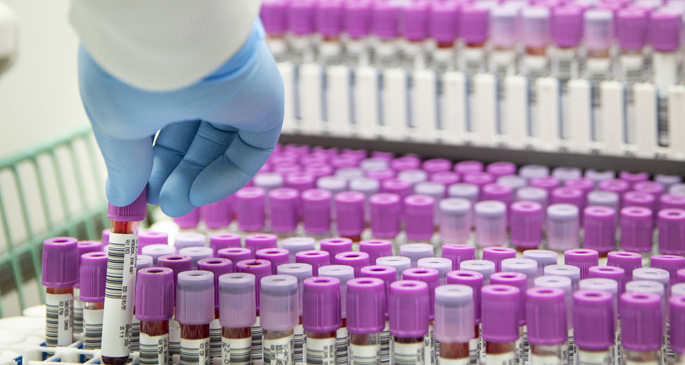The first fruits of a landmark academic-industry partnership that is harvesting the depth and breadth of the human genome to better understand and treat disease will become available to researchers in the spring of 2024.
Underway is whole genome sequencing of DNA samples from approximately 35,000 African American individuals stored in BioVU, Vanderbilt University Medical Center’s massive DNA repository. Over the next two years, another 215,000 genomes from BioVU will be sequenced.

Sequencing data will be provided to researchers through the Alliance for Genomic Discovery (AGD), a partnership created in 2022 by Illumina Inc., a global leader in DNA sequencing and array-based technologies, and Nashville Biosciences, a for-profit VUMC subsidiary.
The sequencing is being conducted by Iceland-based deCODE genetics, a wholly owned subsidiary of the global biopharmaceutical company Amgen, which joined AGD earlier this year.
AGD’s corporate partners, which also include AbbVie, AstraZeneca, Bayer, and Merck, will fund the sequencing cost in return for access to the data for drug discovery and research purposes.
On Oct. 30, the fourth virtual town hall in VUMC’s On the Horizon series featured a progress report on Nashville Biosciences and AGD titled, “A Leap Forward for Precision Medicine,” introduced by Jennifer Pietenpol, PhD, VUMC’s Chief Scientific and Strategy Officer.
Speakers included Nashville Biosciences co-founder and CEO Leeland Ekstrom, PhD, Nashville Biosciences’ chief scientific officer Elizabeth Ann Stringer, PhD, Will Ferguson, MBA, vice president of Pharmaceutical/Biotech Collaborations at Illumina, and Dan Roden, MD, VUMC’s Senior Vice President for Personalized Medicine.
Roden, who is internationally known for his contributions to clinical pharmacology and pharmacogenomics, envisioned BioVU 20 years ago. Today, it is the world’s largest DNA biobank based at a single academic institution, with well over 300,000 samples.
Extracted from discarded blood collected during routine clinical testing, the DNA samples are linked to a “synthetic derivative” — a copy of the electronic medical record from which personal identifying information has been removed.
This matching of genotypes with the corresponding clinical “phenotypes,” including illnesses, treatments and other health measures, enables researchers to ask — and answer — previously unanswerable questions about disease-gene relationships.
Nashville Biosciences, a clinical and genomic analytics company, was established in 2018 to help biopharmaceutical, diagnostics, and other life sciences partners access VUMC’s research resources, including BioVU.
To date, the company has partnered with more than 75 corporate clients to help them identify new disease biomarkers and potential drug targets, optimize clinical trials, and conduct other studies using real-world data.
The agreement with Illumina, and the formation of the Alliance for Genomic Discovery, announced in early 2022, took this effort — and the science behind it — to the next level.
The goal, through whole genome sequencing, is to create a massive library of de-identified health and genomic data collected from patients diverse in gender, race, age and clinical conditions that, in turn, will enrich the discovery and advancement of new methods for diagnosing and treating a host of human diseases.
Amgen’s participation enabled the launch of AGD’s first project, the whole-genome sequencing of approximately 35,000 DNA samples from African Americans, a population currently underrepresented in genomic research.
The lack of diversity in genomic data has created a gap in the scientific understanding of the underlying genetic causes of disease and has inhibited equitable access to precision health therapies. This BioVU cohort, the largest dataset of genomes of its kind to date, will help fill that gap.
Researchers from VUMC and Vanderbilt University will be able to access the data next spring through the BioVU Cloud Terra platform. They are encouraged to register through the StarBRITE online research portal on the Vanderbilt Institute for Clinical and Translational Research website.
Researchers investigating the first pool of sequences will receive guidance from BioVU about the sensitivities and safeguards regarding the use of genomic data from minority and historically marginalized populations. This guidance reflects the recommendations of VUMC’s Racial Equity Task Force.
For example, researchers will have access to resources about the appropriate use of continental ancestry (European, African, etc.), derived from genetic markers, to select their samples, instead of race and ethnicity, which are social constructs and cannot be determined with genomic data.
Roden said genomic datasets like those being built by the AGD will enable researchers to discover rare genetic variations associated with “extreme phenotypes,” why, for instance, some heavy smokers escape lung cancer and live into their 90s.
Breast cancer, heart failure and other diseases will be divided into “subtypes” with different genetic underpinnings. “There are more disease subtypes to be defined,” Roden said, “and it’s only with a very large dataset of genomic data, and if you have phenotypic data, that you can do that.”
Eventually doctors may be able to determine how much of a person’s illness is due to genomic factors, social determinants of health and environmental factors, and target the condition with the most precise and effective therapy.
“Some diseases are 80% written in your genome and some are 2%,” Roden said, with the remaining 98% due to other factors. “That is one of the real challenges and real opportunities with a resource like this,” he said.












